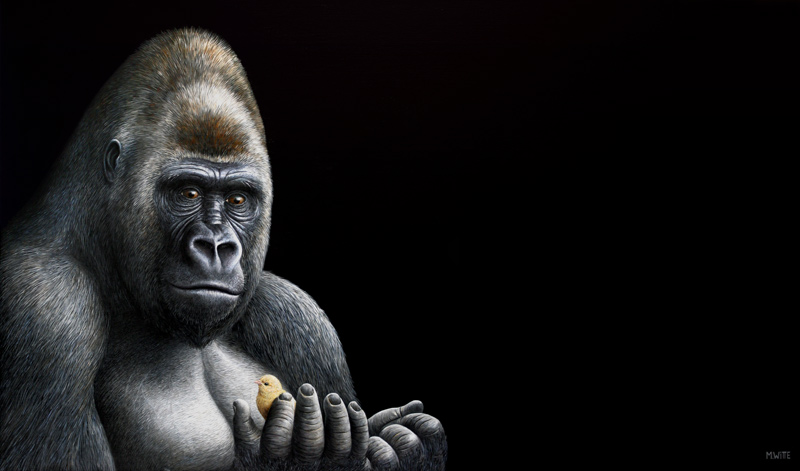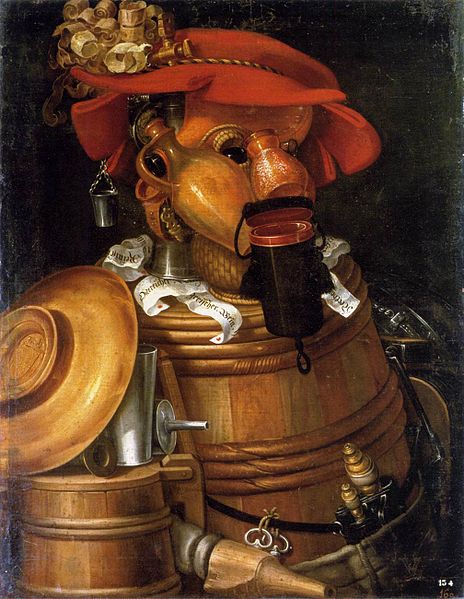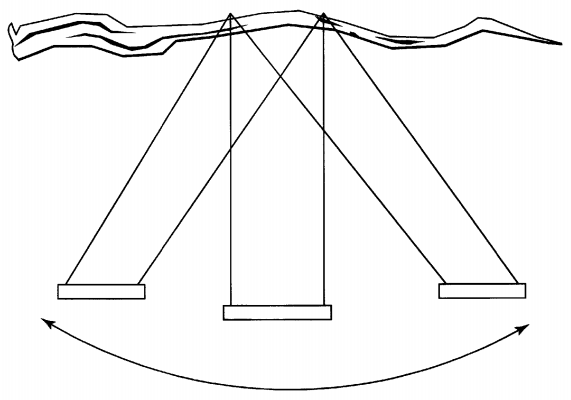
“The more you learn about the dignity of the gorilla, the more you want to avoid people.” — Dian Fossey

“The more you learn about the dignity of the gorilla, the more you want to avoid people.” — Dian Fossey
I find myself more than half convinced by the oddly repellent hypothesis that the peculiarity of the time dimension is not … primitive but is wholly a resultant of those differences in the mere de facto run and order of the world’s filling. It is then conceivable, though doubtless physically impossible, that one four-dimensional area of the time part of the manifold be slewed around at right angles to the rest, so that the time order of that area, as composed by its interior lines of strain and structure, run parallel with a spatial order in its environment. It is conceivable, indeed, that a single whole human life should lie thwartwise of the manifold, with its belly plump in time, its birth at the east and its death in the west, and its conscious stream running alongside somebody’s garden path.
— Donald C. Williams, “The Myth of Passage,” Journal of Philosophy 48:15 (1951), 457-472

The Waiter, by Italian painter Giuseppe Arcimboldo, circa 1574.
Is it a still life or a portrait?
This mechanism, recently restored by Michael Start of the House of Automata, was probably fashioned by Blaise Bontems in Paris around 1890.
It’s an example of a lost art, the “singing bird box,” an early variety of automaton introduced by Pierre Jaquet-Droz in Geneva in 1784. The song is produced by a bellows, a whistle, and a system of cams; many of these devices added a mechanical bird that would flap its wings and open and shut its beak while the sound was produced.
Jaquet-Droz also created a stunning mechanical boy who writes custom texts with a quill pen; that unit, which still works, is made up of some 6,000 pieces.
For a moment in the 1998 Simpsons episode “The Wizard of Evergreen Terrace,” it appears that Homer has found a solution to Fermat’s last theorem:
398712 + 436512 = 447212
If you check this on a calculator with a 10-digit display, it seems to work: Raise 3987 and 4365 each to the 12th power, take the 12th root of the sum, and you get 4472.
But that’s the fault of the display. The actual value for the third term is closer to 4472.000000007057617187512.
Simpsons writer David S. Cohen, who had studied physics at Harvard and contrived the ruse, told Simon Singh he was pleased at the consternation it caused online. “I feel great about it. It’s very easy working in television to not feel good about what you do on the grounds that you’re causing the collapse of society. So, when we get the opportunity to raise the level of discussion — particularly to glorify mathematics — it cancels out those days when I’ve been writing those bodily function jokes.”
(From Simon Singh, The Simpsons and Their Mathematical Secrets, 2013.)

In 1977, West German tourist Erwin Kreuz spent three days enjoying the sights, sounds, and hospitality of Bangor, Maine. Unfortunately, he thought he was in San Francisco, on the other side of the continent. In this week’s episode of the Futility Closet podcast, we’ll describe Kreuz’s unlikely adventure, which made him a local hero in his adopted city.
We’ll also consider an invisible killer and puzzle over a momentous measurement.
Eureka, the esteemed journal of recreational mathematics published at Cambridge University, has placed its archives online under a Creative Commons license. Here’s a problem from May 1940:
The chicken was twice as old when when the day before yesterday was to-morrow to-day was as far from Sunday as to-day will be when the day after to-morrow is yesterday as it was when when to-morrow will be to-day when the day before yesterday is to-morrow yesterday will be as far from Thursday as yesterday was when to-morrow was to-day when the day after to-morrow was yesterday. On what day was the chicken hatched out?
This impressive puzzle appeared recently in the Magpie, a magazine for advanced UK-style cryptic puzzles. See the file for instructions.

In 2002 a 7-year-old boy, Steven Olson, patented a “method of swinging on a swing”:
The method comprises the steps of: a) positioning a user on the seat; and b) having the user pull alternately on one chain to induce movement of the user and the swing toward one side, and then on the other chain to induce movement of the user and the swing toward the other side, to create side-to-side motion.
Steven’s father, Peter, a patent attorney, wanted to show him how the system works. Steven’s submission was approved at first (the patent office said that its technical definition of obviousness “is not necessarily the conventional definition”) but later reconsidered and invalidated, perhaps due to criticism.
A year earlier, to test the workability of a new national patent system, an Australian man had patented the wheel.
There is often peculiar humour about self-frustration. Consider, for example, a train of events which started outside the old Clarendon Laboratory, Oxford. I came across a dirty beaker full of water just when I happened to have a pistol in my hand. Almost without thinking I fired, and was surprised at the spectacular way in which the beaker disappeared. I had, of course, fired at beakers before; but they had merely broken, and not shattered into small fragments. Following Rutherford’s precept I repeated the experiment and obtained the same result: it was the presence of the water which caused the difference in behavior. Years later, after the War, I found myself having to lecture to a large elementary class at Aberdeen, teaching hydrostatics ab initio. Right at the beginning came the definitions — a gas having little resistance to change of volume but a liquid having great resistance. I thought that I would drive the definitions home by repeating for the class my experiments with the pistol, for one can look at them from the point of view of the beaker, thus suddenly challenged to accommodate not only the liquid that it held before the bullet entered it, but also the bullet. It cannot accommodate the extra volume with the speed demanded, and so it shatters.
— R.V. Jones, “Impotence and Achievement in Physics and Technology,” Nature 207:4993 (1965), 120-125
(When the Royal Engineers tried to use this trick to demolish a tall chimney, filling its base with 6 feet of water and firing an explosive charge into the water, “it succeeded so well that it failed completely”: The incompressible water flung the surrounding ring of bricks outward, leaving a foreshortened chimney suspended above in midair. This dropped down neatly onto the old foundation, upright and intact, “presenting the Sappers with an exquisite problem.”)